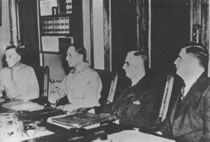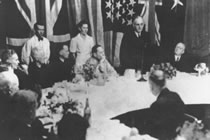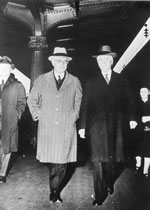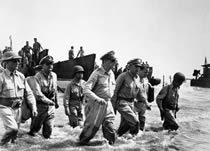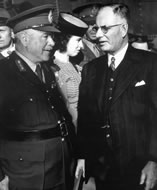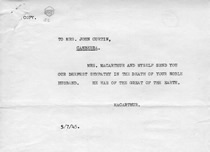
The next phase - March 1943 - Reallocation of commitments
For a time during the first months of 1943 MacArthur remained concerned about a possible Japanese assault against Australia from the northern and north-west and this at a time when any offensives in the Pacific Area were given a very low priority by the allied High Command.51 In preparing for the next offensive stage MacArthur reorganized his command, confirming what had been de facto occurring for some time by effectively removing Blamey's control over the Allied Land Forces in his area, leaving the American forces effectively under MacArthur's own direct command.52 Historian Gavin Long has suggested this 'virtually separate[d] the Australian and American Armies thus simplifying staff work' and avoiding a situation which would have been 'politically unacceptable in Washington'. This was also a period where manpower shortages due to losses from casualty and diseases were concerning the Australian Government and by April Blamey was suggesting that Australia reduce the size of its armed forces in 'areas remote from the enemy'.53
JCPML. Records of David Black. General MacArthur addressing US troops. JCPML00180/66.
On 7 June 1943 MacArthur met with Curtin in Sydney and then announced publicly that 'the days of the holding war were over and it was time to commence the offensive against Japan'. In a public statement released three days later Curtin contended 'I do not think the enemy can now invade this country' and that Australia henceforth would be used as a base from which to launch 'both limited and major offensives against Japan'.54 He then went on to assure the public that
My discussions with General MacArthur were marked by the greatest degree of cordiality, as has always been the case. This country can feel very grateful to General MacArthur, who came here at a critical time, and who has applied himself in such a distinguished way to ensuring the security of Australia as a base...On 30 June a new wave of offensives was launched against various Japanese positions in New Guinea while the Americans also advanced in the Solomons. At the same time, during July the War Cabinet agreed to disband one infantry division within the next six months and perhaps another subsequently.55 Additionally, as the offensives proceeded, Curtin won a landslide election victory on 21 August ensuring his government would have control of both houses of parliament by mid 1944.
JCPML. Records of the Curtin Family. War leadership, 8 June 1943. JCPML00376/73. From left: Nelson Johnson (USA Ambassador), Lady Gowrie, John Curtin, Douglas McArthur, Lord Gowrie (Governor General), Frank Forde.
Strains were clearly developing in the Curtin-MacArthur relationship
In September 1943 a fresh offensive involving Australian troops backed by air and naval forces and some American regiments was launched in New Guinea and Gavan Long has referred to their success by March 1944 in driving the Japanese in 'disorder out of most of mainland New Guinea'.56 As late as October 1943 there had still been more Australian troops than Americans in the combined allied armies in the South West and South Pacific campaigns but even then there were already more actual combat troops among the Americans and as the New Guinea campaign proceeded more rapidly than expected the operational duties of the Australian forces in New Guinea were being slowly taken over by American forces.57 Indeed, by the time Curtin met with MacArthur in Brisbane in November 1943 it was becoming clear that MacArthur's plans, centered on an eventual return to the Philippines, involved using increasingly lower numbers of Australian troops. While in some respects this was in line with Curtin's concern that Australia's war effort needed to be 'rebalanced' to relieve its 'desperate manpower position' Curtin had also to give increasing attention to ensuring that Australia's contribution would be such as to ensure and enhance Australia's role in planning for the postwar world. Strains were clearly developing in the Curtin-MacArthur relationship as the latter planned for the eventual return to the Philippines. Curtin, even before meeting with MacArthur in November, wrote to the latter asking that he (Curtin) be kept at least 'broadly aware of your ideas for the employment of Australian forces in any areas outside Australia and [its] mandated territory'.58
The crew of a United States Flying Fortress running to their stations when the alarm was given for immediate take-off at a base somewhere in Australia, 1942.
Courtesy National Archives of Australia: A11663, PA189
As early as 1 October 1943 a major meeting of the Australian War Cabinet had been held to discuss Australia's future commitments in terms of military forces, levels of food production and its role on the battlefields and in any post-war settlements.59 The war cabinet agreed to release 20,000 men from the armed services and 10,000 from munitions and aircraft industries but with a continued military effort concentrated in the Pacific if necessary at the expense of Australia's commitments in other areas.60
Subsequently in December Blamey issued a policy directive to his senior commanders 'informing them that the operational role of the Australian Military Forces in New Guinea was to be gradually taken over by American forces'.61
JCPML. Records of Douglas MacArthur. Allied War Council conference, Canberra, 194? JCPML00265/17. Original held by MacArthur Memorial Library and Archives: MML&A 10351.
Curtin accepted publicly that his close relationship with MacArthur was coming to an end
In March 1944, the second anniversary of his arrival in Australia, MacArthur was invited to a dinner at Parliament at which a knighthood (recommended to the King by Curtin) was bestowed on him. In his speech on that occasion Curtin accepted publicly that his close relationship with MacArthur was coming to an end. As previously indicated, Curtin, in reflecting on the experience of entrusting Australian forces to 'an officer of another country' as had been done in the past with British officers, referred to MacArthur as having
'exhibited a regard for the rights of this Government and its people, which could not have been exceeded if he had been an officer of our own army'.62
MacArthur in turn responded:
The last two years have been momentous ones for Australia. You have faced the greatest peril in your history. With your very life at stake, you have met and overcome the challenge. It was here that the tide of war turned in the Pacific and the mighty wave of invasion rolled back. Two years ago when I landed on your soil I said to the people of the Philippines whence I came - I shall return'. Tonight I repeat those words. I shall return.63
JCPML. Records of Douglas MacArthur. John Curtin speaks at Parliament dinner in Canberra, 1944. JCPML00265/16. Original held by MacArthur Memorial Library and Archives: MML&A 10048
During this time MacArthur was still working within 'strategic limits' set by the joint Chiefs of Staff, namely to give priority to an advance in the central Pacific towards the Marianas and thence Formosa, a strategy which would develop at the expense of the recapture of the Philippines.66 To avoid his area of command becoming 'a backwater of the war' he had decided to launch an attack on Manus and the nearby island of Los Negros in the Admiralties. He then personally accompanied the successful attacking force on board a cruiser and went ashore briefly on 29 February. With his return to the Philippines considered unlikely before November, an assault on Hollandia in Dutch New Guinea then became the next proposed target and Curtin was informed of these plans at their meeting in March. Interestingly, it was at this time that a short unsuccessful attempt was made by some of MacArthur's supporters in the United States to secure for him the Republican nomination for the 1944 presidential election.
JCPML. Records of the Curtin Family. P.M. John Curtin with U.S.A. Secretary of State, Cordell Hull. Mrs Curtin in R.H. background, Washington, D.C. 1944. JCPML00376/98
General Douglas MacArthur wading ashore in the Philippines, 1944.
Courtesy National Archives of Australia: A6180, 3/6/76/9
On 3 November 1944, barely a fortnight after MacArthur's return to the Philippines, Curtin suffered a serious heart attack. Despite his ill health he was back at the helm by the end of January 1945 and attended his first War Cabinet meeting since his illness on 2 February. In the weeks that followed he was again especially concerned to secure a meaningful 'liberating role for his troops' with Australia's 'military effort... concentrated as far as possible in the Pacific and... on a scale to guarantee her an effective voice in the peace settlement'.71 There were also increasing tensions resulting from Blamey's concerns that his headquarters 'was to be eliminated from the chain of command'.72 Historians have debated the extent of Curtin's personal involvement in the government process during this period but one would probably accept the word of one biographer that 'his interest in the problems continued but his will was greater than his strength.73 On 21 April he returned to hospital and never again returned to active duty.
JCPML. Records of West Australian News Ltd. General Blamey greeting John Curtin in Brisbane on his return from overseas, 1944. JCPML00409/17. Courtesy of West Australian News Ltd.
MacArthur's correspondence appeared to repudiate his promises that AIF divisions would accompany him to Japan
Meanwhile, notwithstanding opposition from Blamey and the Joint Chiefs of Staff who considered the operations unnecessary and likely to cause significant casualties, MacArthur eventually proceeded with a three pronged assault on Borneo using Australian troops. Blamey eventually accepted the first two stages but continued to strongly oppose the third, the proposed landing at the oil refinery centre of Balikpapan. This venture, Blamey told Acting Prime Minister Chifley was 'unimportant and should not be undertaken'74 and his proposal for the Australian 7th Division to be withdrawn from the attacking forces was only overruled after a difficult War Cabinet meeting on 22 May.75 In the meantime the European war had ended on 8 May but, although this meant the release of Australian troops from Europe and North Africa, Australia was now committed to having her troops 'more heavily engaged than at any previous time in the war'.76 Even so, on 28 May the War Cabinet decided on the release of 50,000 men from the Army and RAAF by the end of 1945, with one division still remaining available to MacArthur for the invasion of Japan. During this period David Horner has described aspects of MacArthur's correspondence with the Australian government as 'hardly honest' and, while 'technically correct', such as to 'appear to repudiate his promises that AIF divisions would accompany him to Japan'.77
The invasion of Balikpapan, an operation which by that stage seemed 'even less necessary than... when Blamey had proposed its abandonment'78 was launched on 1 July and MacArthur went ashore soon after the landing. Two days later he returned to Manila and on 5 July received the news that Curtin had died. His telegram to Elsie Curtin on the same day referred to her 'noble husband' as 'of the great of the earth'. The victory which Curtin did not live to see, came within weeks. Indeed, before the end of July, when MacArthur was shown the order for the dropping of the first atomic bomb, it was obvious to him that the intended invasion of Japan would never eventuate. On 15 August 1945 the Japanese Emperor officially announced the surrender.
JCPML. Records of the Curtin Family. Condolences from General Douglas MacArthur, 5 July 1945. JCPML00397/23

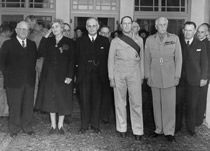
s.jpg)
